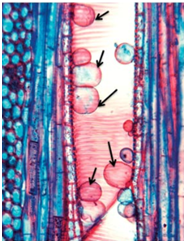In vegetative reproduction by grafting:
I. The vascular cambium tissues of the stock and scion plants must be placed in contact with each other
II. The scion contains the desired genes to be duplicated in future production by the stock/scion plant
III. Generally, grafting is performed when the scion is dormant
1. Only I and II are correct
2. Only I and III are correct
3. Only II and III are correct
4. I, II and III are correct
II. The scion contains the desired genes to be duplicated in future production by the stock/scion plant
III. Generally, grafting is performed when the scion is dormant
2. Only I and III are correct
3. Only II and III are correct
4. I, II and III are correct
The tensile strength of fluid column within a tracheary element is:
1. directly proportional to its diameter
2. inversely proportional to its diameter
3. directly proportional to its length
4. has no relation to the diameter and the length of the tracheary element
If you look at the section of a three year old eudicot stem, the vascular bundles will show:
1. 3 rings of xylem and 3 of phloem.
2. 2 rings of xylem and 1 of phloem.
3. 2 rings of xylem and 3 of phloem.
4. 3 rings of xylem and 1 of phloem.
The diagram shows the development of lateral roots. This development will be called as:
1. Exogenous
2. Endogenous
3. Exarch
4. Endarch
Vascular bundles are continuous from the root to the stem, but different arrangements are found in two cases. What would be true for this arrangement?
1. In the stem they are collateral with endarch xylem while in the root they are radial with exarch xylem
2. In the stem they are collateral with exarch xylem while in the root they are radial with endarch xylem
3. In the stem they are radial with endarch xylem while in the root they are collateral with exarch xylem
4. In the stem they are radial with exarch xylem while in the root they are collateral with endarch xylem
What type of vessels are you most likely to see in metaxylem of a stem?
1. 
2. 
3. 
4. 
In the given diagram if xylem is represented by 1, the companion cells will be represented by:
1. 2
2. 3
3. 4
4. 5
In the section of a monocot leaf shown in the given diagram, what would be true for the structures labeled X?
1. They regulate the opening and closing of the stomata in the adaxial surface of the leaves
2. Due to presence of lignin in their walls they provide support to the leaf surface in windy conditions
3. They are involved in folding and unfolding of leaf tissue to control light intensity and reduce overall water loss
4. They are abnormal cells produced during healing of the adaxial surface after injury and are common portals of entry of viruses into the plants
The balloon like structures seen in vessels in the given diagram are called as:

1. Tyloses
2. Hydathodes
3. P proteins
4. Lenticells
Identify the correct statement regarding A and B [types of concentric vascular bundles] in the given diagram:
1. A is Amphivasal and found in Dracaena while B is amphicribal and found in Selaginella
2. A is Amphivasal and found in Selaginella while B is amphicribal and found in Dracaena
3. A is Amphicribal and found in Dracaena while B is amphivasal and found in Selaginella
4. A is Amphicribal and found in Selaginella while B is amphivasal and found in Dracaena







